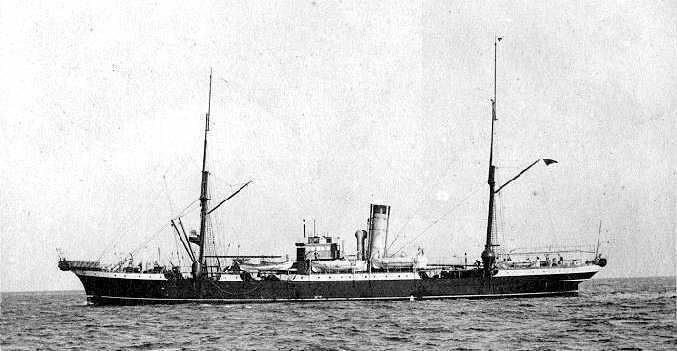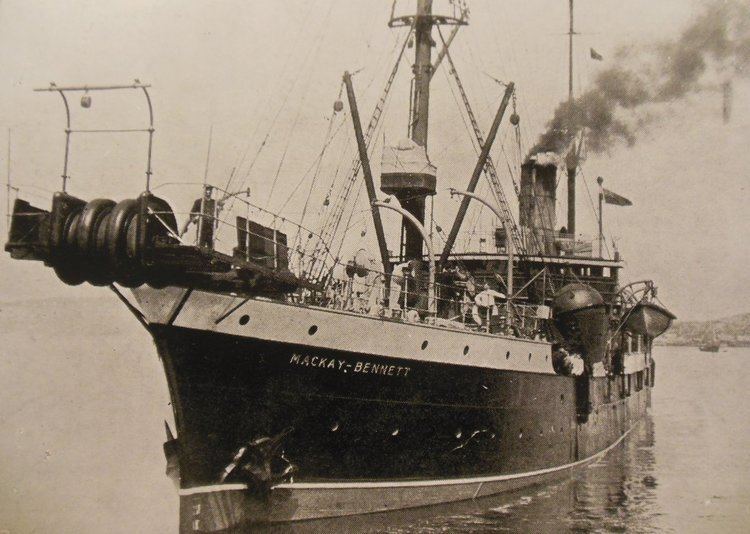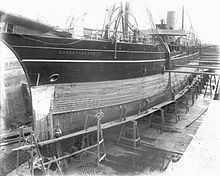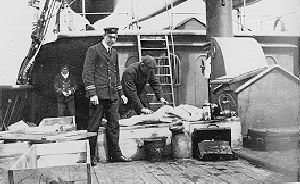Name Mackay-Bennett In service 1884 Launched September 1884 Beam 12 m | Out of service May 1922 Length 82 m | |
 | ||
Builder Fairfield Shipbuilding and Engineering Company | ||
Retrieval and repair of an undersea cable cs mackay bennett
CS Mackay-Bennett was a cable repair ship registered in London, England, owned by the Commercial Cable Company. The ship became infamously known for being the ship that recovered the majority of the victims of the Titanic sinking.
Contents
- Retrieval and repair of an undersea cable cs mackay bennett
- Design and build
- Operations
- Recovery of bodies from wreck of RMS Titanic
- Retirement and scrapping
- References

Design and build

The ship was commissioned from then noted River Clyde-based warship builders John Elder & Co., who incorporated a number of new and then original features into a cable ship. One of the first ships built from steel, she had a relatively deep keel design to: accommodate as much cable as possible; keep the ship stable in the Atlantic Ocean swells; and yet a design which was also very hydrodynamic to keep her fuel efficient and fast in operation. The hull design included bilge keels to keep her stable, and she had two rudders, one fore and one aft, to maximize manoeuvrability.
Operations

Named after the two founders of her owners, the sailors who served aboard her pronounced the name "Macky-Bennett." Mainly based out of Halifax, Nova Scotia, where she first arrived in March 1885, she was also often used for operations on the European side of the Atlantic, based out of Plymouth, England. The Canadian author Thomas Raddall worked as wireless operator aboard Mackay-Bennett and based some short stories on his experiences aboard.

In addition to carrying out numerous difficult cable repairs, many during times of wartime danger, due to the nature of her work and resultant position in the Atlantic, Mackay-Bennett performed many rescues. Typical was the rescue of the crew of the sinking schooner Caledonia on February 12, 1912.
Recovery of bodies from wreck of RMS Titanic

In April 1912, whilst working on maintaining the France-to-Canada communications cable, the ship became famous as the first vessel contracted by the White Star Line to carry out the difficult task of recovering the bodies left floating in the North Atlantic, after the Titanic disaster. After returning to port in Halifax, Nova Scotia and clearing out her cable stores, her captain Frederick H. Larnder took on board above her normal supplies. Specialized personnel and supplies taken on board for the assignment included:
The ship left Halifax at 12:28PM on Wednesday, 17 April 1912. Due to severe fog and rough seas it took the ship nearly four days to sail the 800 nautical miles (1,500 km; 920 mi) to the scene of the disaster. The captain instructed the ship's crew to keep their logbooks complete and up to date during the voyage and subsequent recovery operation, but only two logbooks are presently known to have survived: seven pages from the logbook of engineer Frederick A. Hamilton, now kept in the National Maritime Museum, England, and the personal diary of Clifford Crease, a 24-year-old Naval artificer (craftsman-in-training); much of the detailed account of the recovery operation is today traced to Crease's diary, now held in the Public Archives of Nova Scotia.
Having arrived the previous night, recovery of bodies started at 06:00 on April 20. CS Mackay-Bennett was anchored close to but not within the recovery area, and she offloaded her skiff lifeboats. Crews then rowed into the recovery area and manually recovered the bodies into the skiffs. After recovering as many bodies as they deemed safe for the return journey (51 corpses), the crews then rowed back to the CS Mackay-Bennett. The captain noted that there were neither sufficient space aboard to store all of the recovered bodies nor enough embalming supplies aboard. As the Canadian Government and associated burial and maritime laws directed that any bodies carried had to be embalmed before a ship enter a Canadian port, the captain agreed to a system whereby:
At 19:00 on 23 April, CS Mackay-Bennett lay briefly alongside the Allan Shipping Line's Sardinian (en route to Saint John, New Brunswick), to collect additional canvas.
Just after midnight on 26 April, CS Mackay-Bennett rendezvoused with the Anglo-American Telegraph Company's CS Minia to get extra embalming supplies, before departing for Halifax at dawn that day.
After a seven-day recovery operation, the CS Mackay-Bennett had:
With the body of the unknown child unclaimed, the crew paid for the burial and headstone monument out of their own wages; the casket was marked by a copper plaque reading "Our Babe". The entire ship's crew, together with the majority of the population of Halifax, attended the child's burial at Fairview Lawn Cemetery on 4 May 1912. With improved DNA testing, on 30 July 2007 Canadian researchers at Lakehead University announced that testing of the body's mitochondrial DNA had revealed that the child was 19-month-old Sidney Leslie Goodwin.
After his death in 1955, Clifford Crease's body was interned only a few metres away from the grave of "Our Babe", a site he had visited on every anniversary of the tragedy during his lifetime.
Retirement and scrapping
The ship was retired in May 1922, anchored in Plymouth Sound to be used as a storage hulk. During The Blitz on England, she was sunk during a Nazi Germany Luftwaffe attack but later refloated. Her hulk was finally scrapped in 1963.
